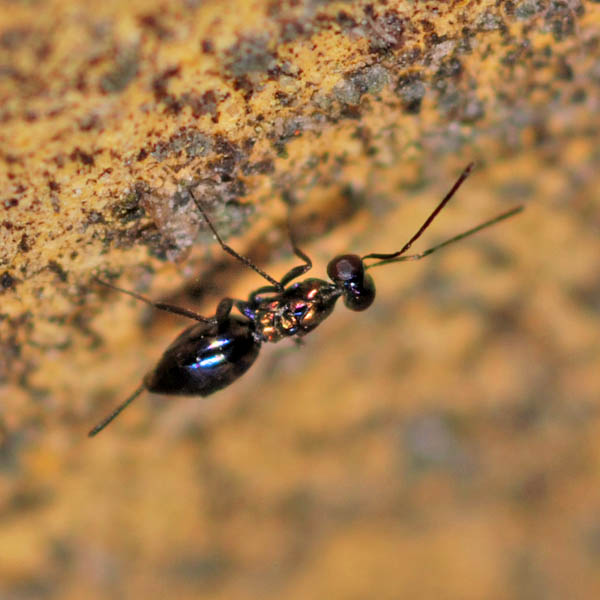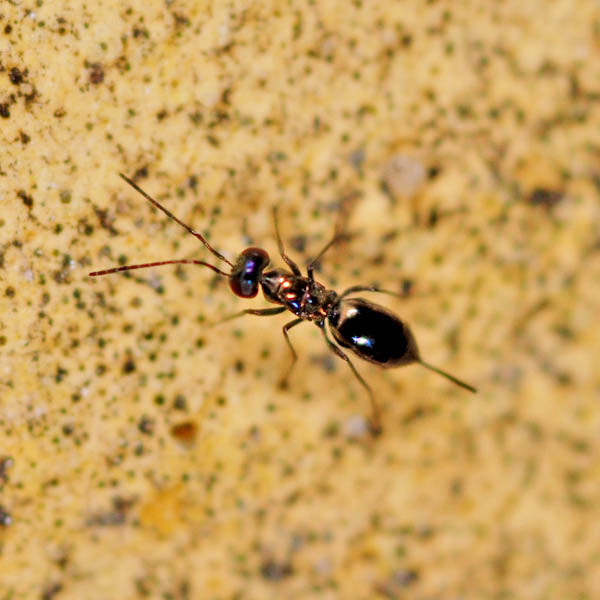Diptera.info :: Identification queries :: Other insects, spiders, etc.
Who is here? 1 guest(s)
|
Wingless Hymenoptera, March 2008, Hungary
|
|
| Xespok |
Posted on 23-06-2008 13:05
|
|
Member Location: Debrecen, Hungary Posts: 5550 Joined: 02.03.05 |
Can someone tell me something about this tiny wasp.
Xespok attached the following image:  [84.87Kb] Gabor Keresztes Japan Wildlife Gallery Carpathian Basin Wildlife Gallery |
| Xespok |
Posted on 23-06-2008 13:06
|
|
Member Location: Debrecen, Hungary Posts: 5550 Joined: 02.03.05 |
Another view of the same animal.
Xespok attached the following image:  [82.7Kb] Gabor Keresztes Japan Wildlife Gallery Carpathian Basin Wildlife Gallery |
| ChrisR |
Posted on 23-06-2008 13:31
|
|
Administrator Location: Reading, England Posts: 7699 Joined: 12.07.04 |
I first thought it looked like a braconid but the long first antennal segments suggest a chalcidoid perhaps, but I'm not sure which family it could be within that.  |
| cthirion |
Posted on 30-06-2008 23:19
|
|
Member Location: Awirs (Flémalle) Belgique Posts: 901 Joined: 13.08.04 |
Chalcidoidea, Eupelmidae. Eupelmus sp sous-genre Macroneura. Jean-Luc Vago (France) cthirion |
| Xespok |
Posted on 01-07-2008 23:16
|
|
Member Location: Debrecen, Hungary Posts: 5550 Joined: 02.03.05 |
Thx Camille and Jean-Luc.
Gabor Keresztes Japan Wildlife Gallery Carpathian Basin Wildlife Gallery |
| jorgemotalmeida |
Posted on 01-07-2008 23:18
|
|
Member Location: Viseu - PORTUGAL Posts: 9295 Joined: 05.06.06 |
I love Eupelmidae along with Mutillidae!  |
| Gerard Pennards |
Posted on 01-07-2008 23:32
|
|
Member Location: Amersfoort Posts: 1914 Joined: 07.06.04 |
Well, I don't want to spoil the party, but it doesn't seem like an Eupelmid to me! As the sister group of Encyrtidae they should have an enlarged second leg, tibia and tars with a larger spine at the end of the tibia. I know the genus, in the key of Peck, Boucek and Hoffer (1964) it is listed as genus Eupelmella. I see them sometimes in the samples at work, and one of the characteristics is the abruptly bent upwards distal part of the wing stump. I don't see that in this animal. It has stumps, but in Eupelmella these are bigger and the bent upwards distal part is clearly visible,not like in this one. My idea about this would be more like family Eulophidae! Greetings, Edited by Gerard Pennards on 01-07-2008 23:35 Greetings, Gerard Pennards |
|
|
|
| Paul Beuk |
Posted on 02-07-2008 08:27
|
|
Super Administrator Location: Netherlands Posts: 19363 Joined: 11.05.04 |
I don't want to spoil your party either but I think I can see five tarsal segments in the top picture, so not Eulophidae. 
Paul - - - - Paul Beuk on https://diptera.info |
| cthirion |
Posted on 02-07-2008 15:55
|
|
Member Location: Awirs (Flémalle) Belgique Posts: 901 Joined: 13.08.04 |
It is of my fault, I had not sent the photograph where the tarses in detail are seen.  I returned for opinion again! cthirion |
| Christian Schmid-Egger |
Posted on 02-07-2008 17:17
|
|
Member Location: Germany, Berlin Posts: 233 Joined: 05.08.05 |
Hannes Baur, Bern, identified it as the Pteromalide Cea pulicaris Walker, 1837. He also wrote that it is an "unusual" Pteromalid. Regards, Christian |
| Gerard Pennards |
Posted on 02-07-2008 18:39
|
|
Member Location: Amersfoort Posts: 1914 Joined: 07.06.04 |
Well yeah Paul, As you can see it was late!   Didn't count tarsal number, just remembered Euepelmella looks very different,. But indeed Pteromalidae fits it much better, even a bit unusual one! Greetings, Gerard Pennards |
|
|
|
| jorgemotalmeida |
Posted on 02-07-2008 19:29
|
|
Member Location: Viseu - PORTUGAL Posts: 9295 Joined: 05.06.06 |
a very unusual pteromalid, indeed!!  |
| Xespok |
Posted on 04-07-2008 17:23
|
|
Member Location: Debrecen, Hungary Posts: 5550 Joined: 02.03.05 |
Thx for everyone for the identification. I'll switch to Christian's forum to post Hymenoptera querries in the future.
Gabor Keresztes Japan Wildlife Gallery Carpathian Basin Wildlife Gallery |
| cthirion |
Posted on 13-07-2008 18:30
|
|
Member Location: Awirs (Flémalle) Belgique Posts: 901 Joined: 13.08.04 |
I went a little quickly in my determination of the apterous chalcidien. It is not a question indeed of Eupelmidae as I had considered pr?cedemment but I agree with Hannes Baur for Pteromalidae Cea pulicaris.  Vago J.L. cthirion |
| Jump to Forum: |














